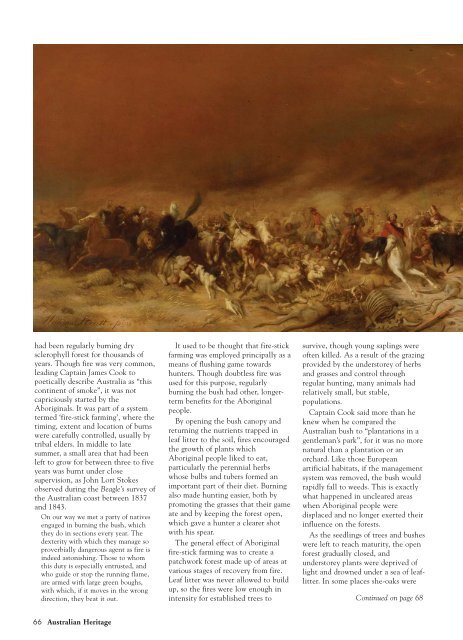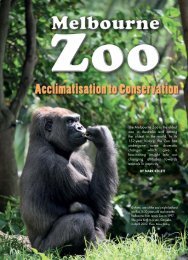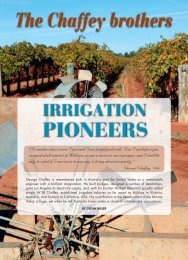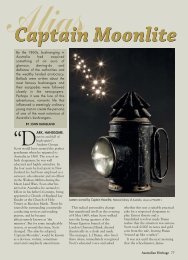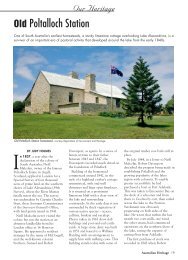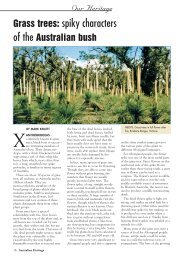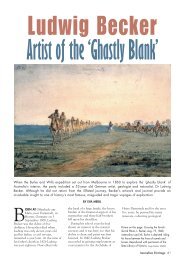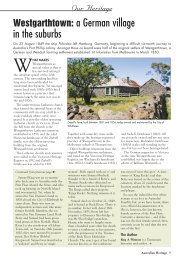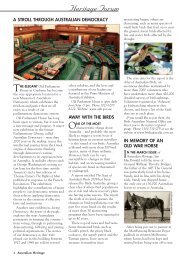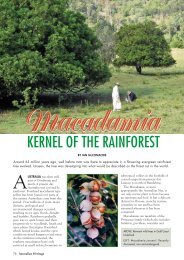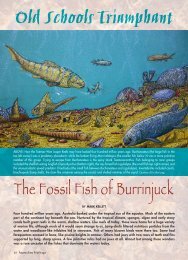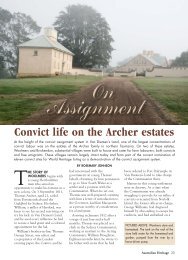Heritage 0308_Bushfire.pdf - Australian Heritage Magazine
Heritage 0308_Bushfire.pdf - Australian Heritage Magazine
Heritage 0308_Bushfire.pdf - Australian Heritage Magazine
Create successful ePaper yourself
Turn your PDF publications into a flip-book with our unique Google optimized e-Paper software.
had been regularly burning dry<br />
sclerophyll forest for thousands of<br />
years. Though fire was very common,<br />
leading Captain James Cook to<br />
poetically describe Australia as “this<br />
continent of smoke”, it was not<br />
capriciously started by the<br />
Aboriginals. It was part of a system<br />
termed ‘fire-stick farming’, where the<br />
timing, extent and location of burns<br />
were carefully controlled, usually by<br />
tribal elders. In middle to late<br />
summer, a small area that had been<br />
left to grow for between three to five<br />
years was burnt under close<br />
supervision, as John Lort Stokes<br />
observed during the Beagle’s survey of<br />
the <strong>Australian</strong> coast between 1837<br />
and 1843.<br />
On our way we met a party of natives<br />
engaged in burning the bush, which<br />
they do in sections every year. The<br />
dexterity with which they manage so<br />
proverbially dangerous agent as fire is<br />
indeed astonishing. Those to whom<br />
this duty is especially entrusted, and<br />
who guide or stop the running flame,<br />
are armed with large green boughs,<br />
with which, if it moves in the wrong<br />
direction, they beat it out.<br />
It used to be thought that fire-stick<br />
farming was employed principally as a<br />
means of flushing game towards<br />
hunters. Though doubtless fire was<br />
used for this purpose, regularly<br />
burning the bush had other, longerterm<br />
benefits for the Aboriginal<br />
people.<br />
By opening the bush canopy and<br />
returning the nutrients trapped in<br />
leaf litter to the soil, fires encouraged<br />
the growth of plants which<br />
Aboriginal people liked to eat,<br />
particularly the perennial herbs<br />
whose bulbs and tubers formed an<br />
important part of their diet. Burning<br />
also made hunting easier, both by<br />
promoting the grasses that their game<br />
ate and by keeping the forest open,<br />
which gave a hunter a clearer shot<br />
with his spear.<br />
The general effect of Aboriginal<br />
fire-stick farming was to create a<br />
patchwork forest made up of areas at<br />
various stages of recovery from fire.<br />
Leaf litter was never allowed to build<br />
up, so the fires were low enough in<br />
intensity for established trees to<br />
survive, though young saplings were<br />
often killed. As a result of the grazing<br />
provided by the understorey of herbs<br />
and grasses and control through<br />
regular hunting, many animals had<br />
relatively small, but stable,<br />
populations.<br />
Captain Cook said more than he<br />
knew when he compared the<br />
<strong>Australian</strong> bush to “plantations in a<br />
gentleman’s park”, for it was no more<br />
natural than a plantation or an<br />
orchard. Like those European<br />
artificial habitats, if the management<br />
system was removed, the bush would<br />
rapidly fall to weeds. This is exactly<br />
what happened in uncleared areas<br />
when Aboriginal people were<br />
displaced and no longer exerted their<br />
influence on the forests.<br />
As the seedlings of trees and bushes<br />
were left to reach maturity, the open<br />
forest gradually closed, and<br />
understorey plants were deprived of<br />
light and drowned under a sea of leaflitter.<br />
In some places she-oaks were<br />
Continued on page 68<br />
66 <strong>Australian</strong> <strong>Heritage</strong>


